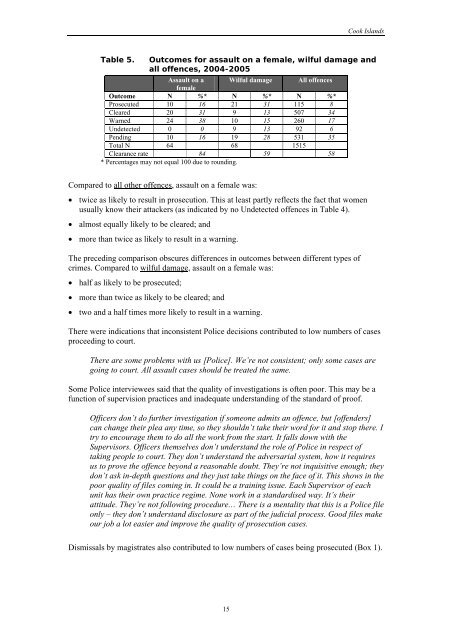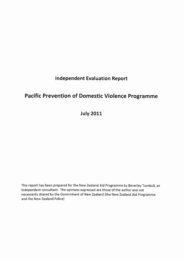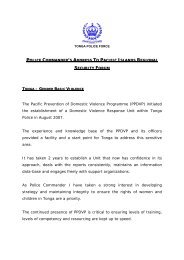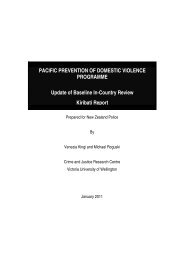Cook Islands - Pacific Prevention of Domestic Violence Programme
Cook Islands - Pacific Prevention of Domestic Violence Programme
Cook Islands - Pacific Prevention of Domestic Violence Programme
You also want an ePaper? Increase the reach of your titles
YUMPU automatically turns print PDFs into web optimized ePapers that Google loves.
<strong>Cook</strong> <strong>Islands</strong><br />
Table 5.<br />
Outcomes for assault on a female, wilful damage and<br />
all <strong>of</strong>fences, 2004-2005<br />
Assault on a Wilful damage All <strong>of</strong>fences<br />
female<br />
Outcome N %* N %* N %*<br />
Prosecuted 10 16 21 31 115 8<br />
Cleared 20 31 9 13 507 34<br />
Warned 24 38 10 15 260 17<br />
Undetected 0 0 9 13 92 6<br />
Pending 10 16 19 28 531 35<br />
Total N 64 68 1515<br />
Clearance rate 84 59 58<br />
* Percentages may not equal 100 due to rounding.<br />
Compared to all other <strong>of</strong>fences, assault on a female was:<br />
• twice as likely to result in prosecution. This at least partly reflects the fact that women<br />
usually know their attackers (as indicated by no Undetected <strong>of</strong>fences in Table 4).<br />
• almost equally likely to be cleared; and<br />
• more than twice as likely to result in a warning.<br />
The preceding comparison obscures differences in outcomes between different types <strong>of</strong><br />
crimes. Compared to wilful damage, assault on a female was:<br />
• half as likely to be prosecuted;<br />
• more than twice as likely to be cleared; and<br />
• two and a half times more likely to result in a warning.<br />
There were indications that inconsistent Police decisions contributed to low numbers <strong>of</strong> cases<br />
proceeding to court.<br />
There are some problems with us [Police]. We’re not consistent; only some cases are<br />
going to court. All assault cases should be treated the same.<br />
Some Police interviewees said that the quality <strong>of</strong> investigations is <strong>of</strong>ten poor. This may be a<br />
function <strong>of</strong> supervision practices and inadequate understanding <strong>of</strong> the standard <strong>of</strong> pro<strong>of</strong>.<br />
Officers don’t do further investigation if someone admits an <strong>of</strong>fence, but [<strong>of</strong>fenders]<br />
can change their plea any time, so they shouldn’t take their word for it and stop there. I<br />
try to encourage them to do all the work from the start. It falls down with the<br />
Supervisors. Officers themselves don’t understand the role <strong>of</strong> Police in respect <strong>of</strong><br />
taking people to court. They don’t understand the adversarial system, how it requires<br />
us to prove the <strong>of</strong>fence beyond a reasonable doubt. They’re not inquisitive enough; they<br />
don’t ask in-depth questions and they just take things on the face <strong>of</strong> it. This shows in the<br />
poor quality <strong>of</strong> files coming in. It could be a training issue. Each Supervisor <strong>of</strong> each<br />
unit has their own practice regime. None work in a standardised way. It’s their<br />
attitude. They’re not following procedure… There is a mentality that this is a Police file<br />
only – they don’t understand disclosure as part <strong>of</strong> the judicial process. Good files make<br />
our job a lot easier and improve the quality <strong>of</strong> prosecution cases.<br />
Dismissals by magistrates also contributed to low numbers <strong>of</strong> cases being prosecuted (Box 1).<br />
15














